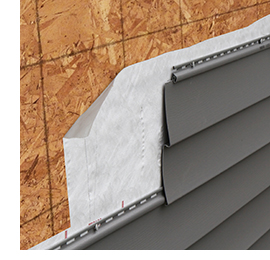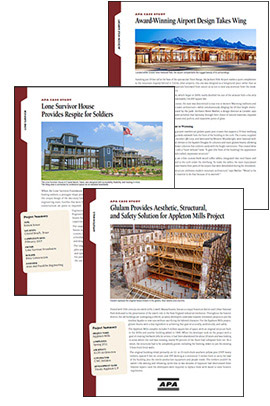 Click on the links to learn more or download APA's new and updated content.
Click on the links to learn more or download APA's new and updated content.
July 2015
NEW GUIDE
Nail-Base Sheathing for Siding and Trim Attachment
 Walls continuously sheathed in plywood or OSB provide an excellent, code-compliant nail base for siding and trim when the correct fastening method is used. In typical construction, siding, trim, and brick ties are attached to framing members. According to the code, they can also be attached directly to nail-base structural sheathing when the correct fastening method is used. There are numerous advantages to using continuously sheathed plywood or OSB walls as a nail base for siding and trim:
Walls continuously sheathed in plywood or OSB provide an excellent, code-compliant nail base for siding and trim when the correct fastening method is used. In typical construction, siding, trim, and brick ties are attached to framing members. According to the code, they can also be attached directly to nail-base structural sheathing when the correct fastening method is used. There are numerous advantages to using continuously sheathed plywood or OSB walls as a nail base for siding and trim:
- Helps meet code requirements—ensures that all siding ends and trim are fastened to a solid substrate
- Eliminates the need to install additional wall studs, saving expense on time and materials
- Allows for the use of popular siding products when studs are at 24 inches on center
- Eliminates the need to locate hidden studs, which is especially tricky when house wrap or continuous insulation covers the walls
- During high-wind events, helps ensure that siding remains in place and maintains structural integrity of the building if the siding is penetrated
APA’s new guide, Nail-Base Sheathing for Siding and Trim Attachment, Form Q250, provides an easy method for determining the type and spacing of siding fasteners to satisfy building code requirements when using wood structural panel sheathing as a nail base for siding and trim. This method works with popular cladding products such as vinyl, wood, fiber cement, APA-Rated lap and panel siding, aluminum, and other cladding products with weights of 3 psf or less. To learn more, download the new guide: Nail-Base Sheathing for Siding and Trim Attachment.
ADVANCED FRAMING
The Inside View Project
 This new demonstration home in the Chicago area offers an inside look at energy-efficient framing methods. The Inside View Project uses framing that conserves energy, speeds construction, reduces labor and waste, exceeds structural requirements, and saves homeowners money on their energy bills.
This new demonstration home in the Chicago area offers an inside look at energy-efficient framing methods. The Inside View Project uses framing that conserves energy, speeds construction, reduces labor and waste, exceeds structural requirements, and saves homeowners money on their energy bills.
Using advanced framing techniques like 2x6 studs spaced 24 inches on center, energy-efficient corners, and continuous sheathing with wood structural panels, the Inside View Project is framed to maximize room for insulation while maintaining excellent structural integrity. A premium, yet cost-effective flooring system uses deeper, stiffer and stronger I-joists and thicker floor sheathing for an affordable high-performance floor that is quicker to install.
The Inside View Project is a collaboration between APA – The Engineered Wood Association, the USDA US Forest Service, Forest Products Laboratory, and Beechen & Dill Homes. For more information, visit The Inside View Project.
NEW CASE STUDIES
Appleton Mills
 This renovation in historic Lowell, Massachusetts, turned 1870s and 1900s brick structures that once housed textile mills into hip, modern work/live lofts. At the start, the buildings were in extreme disrepair and had to be gutted, with only the original brick facades retained. With the size and number of original heavy timbers nearly impossible to source, glulam from APA-member Rosboro was identified as an historically accurate replacement. Glulam floor decking, girders, floor beams, and columns were used to entirely reframe the now-revitalized complex, which totals about 5 million square feet of space. To learn more, download Appleton Mills: Glulam Provides Aesthetic, Structural, and Safety Solution, Form R145.
This renovation in historic Lowell, Massachusetts, turned 1870s and 1900s brick structures that once housed textile mills into hip, modern work/live lofts. At the start, the buildings were in extreme disrepair and had to be gutted, with only the original brick facades retained. With the size and number of original heavy timbers nearly impossible to source, glulam from APA-member Rosboro was identified as an historically accurate replacement. Glulam floor decking, girders, floor beams, and columns were used to entirely reframe the now-revitalized complex, which totals about 5 million square feet of space. To learn more, download Appleton Mills: Glulam Provides Aesthetic, Structural, and Safety Solution, Form R145.
Jackson Hole Airport
This award-winning airport is a beautiful, yet unassuming structure that complements its montane setting to perfection. “The structure celebrates modern mountain architecture,” says Architect Brent Mather. “Wood is the perfect material to do that because of its warmth.” With premium-appearance exposed glulam trusses from APA-member QB Corp, Douglas-fir columns, a tongue-and-groove ash wood ceiling, and other natural elements, the airport’s renovation stays true to its surroundings. To learn more, download Jackson Hole Airport: Award-Winning Design Takes Wing, Form R110.
Lone Survivor Retreat
The Lone Survivor Foundation’s new retreat in Crystal Beach, Texas, was designed to honor and to serve the needs of combat-injured veterans. The retreat is an unusual structure, a collection of multi-story buildings on piers that includes a soldier bunk house and conference center. The unique requirements of the project were met through use of treated glulam beams from APA-member Anthony Forest Products Company. Stronger and more versatile than standard lumber, the glulam was ideal for framing the obtuse angles of the unconventional floor plan. “The glulam beams were instrumental in having the house come together really well,” says Chandra Franklin Womack, PE, of Aran and Franklin Engineering. To read more, download the case study: Lone Survivor House Provides Respite for Soldiers, Form R115.
NEW TECHNICAL TOPIC
LVL Scaffold Planks Versus LVL Planks
LVL scaffold planks must support, at a minimum, at 250-pound person at the center of a 10-foot span. LVL scaffold planks must meet additional requirements stipulated in OSHA and ANSI/ASSE A10.8 and carry a special trademark that identifies them as scaffold planks. Download Technical Topic: LVL Scaffold Planks Versus LVL Planks, Form TT-120.
Is APA on your "approved" list?
Add webupdates@apawood.org to your approved list to make sure APA communications don't get stuck in your provider's spam filter.
Answers to Your Questions
Where to get APA publications: Over 500 publications are available for no charge and can be immediately downloaded in PDF format. Many are also available in printed format for a nominal fee. Visit the APA Resource Library to download or order.
Login help and account updates: If you forgot your password—or need to update your user information or email address—visit the User Login page.
PDF troubleshooting tips: View our PDF Troubleshooting page for answers to common questions regarding PDF downloads.
Engineered wood product support: Contact the APA Support Help Desk via the online contact form, email help@apawood.org, or call 253-620-7400.
Visit APA on Facebook and Twitter
Have you checked out APA's Facebook or Twitter page recently? Be sure to visit the pages often for the latest APA news, publications and events, as well as related industry resources and information.